2000 Best Practice Awards
"Local" Winners: San Diego Area Office
2000-647 San Diego Regional Partners in Homeownership
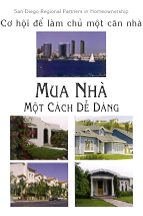 The San Diego Regional Partners in Homeownership
was created on July 26, 1996 by the U.S. Department of Housing and Urban
Development to work in conjunction with the National Partners in Homeownership.
Members of this group include representatives from public, private and
non-profit organizations. The Partners’ purpose is to promote the
value of homeownership in the San Diego region. The main objectives include
cutting the costs of homeownership, opening markets and expanding opportunities
for homeownership.
The San Diego Regional Partners in Homeownership
was created on July 26, 1996 by the U.S. Department of Housing and Urban
Development to work in conjunction with the National Partners in Homeownership.
Members of this group include representatives from public, private and
non-profit organizations. The Partners’ purpose is to promote the
value of homeownership in the San Diego region. The main objectives include
cutting the costs of homeownership, opening markets and expanding opportunities
for homeownership.
In 1999, the San Diego Regional Partners
in Homeownership conducted special outreach 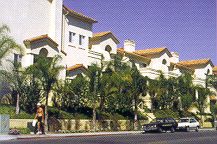 efforts to renters and homebuyers
in the San Diego region. As part of collaborative efforts between its members
to make resources available to homebuyers, the Partnership drafted "Homebuying
Made Easy," a brochure to encourage homeownership and attendance at
homeownership education classes. This brochure was translated into Spanish,
Chinese and Vietnamese, to correspond to the types of classes offered to
the public.
efforts to renters and homebuyers
in the San Diego region. As part of collaborative efforts between its members
to make resources available to homebuyers, the Partnership drafted "Homebuying
Made Easy," a brochure to encourage homeownership and attendance at
homeownership education classes. This brochure was translated into Spanish,
Chinese and Vietnamese, to correspond to the types of classes offered to
the public.
2000-87 Vistans R.O.C. (Revitalizing Our Community)
The intent of Vistans R.O.C. was to create
a sense of community and to revitalize an entire street in the Townsite
neighborhood within the City of Vista, California. Over 850 volunteers
converged on the street, East Los Angeles, for one day to clean up and
paint 22 homes. Volunteers came from all over the neighboring communities,
including local business owners, local charitable organizations, local
public and private schools, and community groups. New landscaping and picket
fences were installed for the homes of the participants. Absentee landlords
contributed a fee so their homes would be included.
Vistans R.O.C. will be an annual event with
other blocks in the revitalization strategy area being chosen. As a follow
up, SER Inc. and Washington Mutual Bank are continuing to rehabilitate
homes further down the street and are conducting a contest for the best
exterior enhancement on two adjacent streets.
2000-165 San Diego HUD Office Annual Report 2000
This spiraled 26-page report describes HUD
programs and accomplishments in San Diego and Imperial Counties for Fiscal
Year 1999. HUD’s funded programs, HUD Community Builders and Field
Office Staff members are listed. Through colorful photographs, it showcases
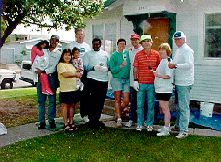 success stories, features developments/projects,
and highlights special efforts in the San Diego region to attain HUD’s
six strategic goals. It features the many faces and activities of our community
partners. This is an informative document, helping to restore public trust
by highlighting accomplishments, describing results, and informing the
general community about how HUD staff and HUD programs assist needy persons
and aid communities. Click here to view more photos.
success stories, features developments/projects,
and highlights special efforts in the San Diego region to attain HUD’s
six strategic goals. It features the many faces and activities of our community
partners. This is an informative document, helping to restore public trust
by highlighting accomplishments, describing results, and informing the
general community about how HUD staff and HUD programs assist needy persons
and aid communities. Click here to view more photos.
2000-166 Oxford Terrace Apartments "Community of Helping Hands"
The Oxford Terrace Apartments in Chula Vista,
California, is not only a beautiful apartment complex but is truly an "Apartment
Community of Helping Hands." This 132-unit HUD-assisted family complex
uses resident volunteers community partners, and concerned management staff
to run a service enriched apartment community. Services to the residents
include a monthly food distribution program, staff a computer learning
center that includes Internet connection, help with a mobile medical screening
and testing program, "English as a Second Language" program,
CPR and First Aid Classes, resident shuttle service, and active partnership
with local law enforcement in a Crime Free Multi-Housing program.
2000-1644 North County Housing Summit for "Regional Solutions"
The Housing and Neighborhood Services Department
of the City of Oceanside called together 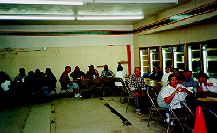 elected officials, civic leaders and housing specialists
from across North San Diego County to discuss the growing problem of housing
for low- and moderate-income families. Over 100 participants gathered to
share their experiences, to identify resources, to develop strategic plans
to address the problem and to form a coalition of stake holders to obtain
political and community support.
elected officials, civic leaders and housing specialists
from across North San Diego County to discuss the growing problem of housing
for low- and moderate-income families. Over 100 participants gathered to
share their experiences, to identify resources, to develop strategic plans
to address the problem and to form a coalition of stake holders to obtain
political and community support.
2000-2649 Maya Apartments
Maya Apartments, a 132-unit apartment complex
is located in the northern area of the City of San Diego in the community
of Mira Mesa. It was acquired and rehabilitated by the San Diego Housing
Commission (SDHC) using HOME funds and tax-exempt bonds, and is operated
by SDHC as a mixed-income residential community. The Maya Apartments consist
of 40 units with rents affordable to very-low-income households (50 percent
MAI) and the remaining units are rented at market-rate. HOME units are
"floating" (fully dispersed throughout the complex; the property
manager maintains discretion over which units are affordable).
2000-167 Community Opportunities Program Section 8 Symposiums On October
15, 1999 and January 14, 2000, the Fair Housing
Council of San Diego, Inc., conducted symposiums
(as part of a free series ) under the auspices of its Community Opportunities
Program (CO), a housing counseling and mobility program. The Section 8
Symposiums sought to encourage owners and apartment managers to participate
in the Section 8 housing rental assistance program. Conference planners
invited property Managers and Owners of Rental Property and provided a
presentation on how the Section 8 housing program currently being implemented
by five local housing authorities in the San Diego region offered more
benefits than ever for property owners.
The Symposiums created the opportunity to
change a sometimes negative image which regional owners may have about
housing subsidy programs. Especially in San Diego where some HUD housing
units are "at risk" of being lost, it is extremely important
to keep the lines of communication open with property owners. These owners
are crucial to recruit as housing providers for low and moderate income
and workforce families. Without an adequate supply of housing and the cooperation
of the owners, housing goals of HUD programs will go unmet. Education programs
for owners are much appreciated.
2000-648 Parker-Kier Building
The beautifully renovated Parker-Kier Building
is heralded as the first development of its kind in San Diego. Winner of
a coveted national award from the Association of Local Housing Finance
Agencies, the 34-unit rental housing facility provides affordable housing
to a critically undeserved population of homeless persons living with mental
illness while preserving a piece of San Diego’s architectural heritage.
2000-994 Critical Hours Program of Greater Golden Hill CDC
The Critical Hours Program operated by Greater
Golden Hill Community Development Corporation (GGHCDC) provides computer
and internet access for middle school aged youth along with tutoring, sports
field trips and health, tobacco and substance abuse classes. Started in
1998, the Program is in a facility in the northern part of the Golden Hill
community of San Diego County. GGHCDC has provided after school art and
dance programs, four days a week at the local elementary school since 1992.
Over 200 youth participate on a weekly basis.
2000-1071 8th Annual Nonprofit Federation Conference
The Nonprofit Federation for Housing and
Community Development (NPF) holds a conference in the fall of each year.
The 8th Annual Nonprofit Conference held on October 28, 1999 was extremely
successful with over 275 registered participants and 50 speakers. This
annual conference is one of the few opportunities to bring together from
the entire San Diego region groups, agencies and individuals who produce
and manage affordable rental housing, who work with the homeless, who work
to increase homeownership and who provide economic development. The NPF
staff recruits volunteers from diverse groups to produce sessions and workshops
as well as awarding scholarships to tenant groups to ensure to a broad
diversity of representation.
2000-1153 San Martin de Porres Apartments
The project sponsors, Metropolitan Area Advisory
Committee MAAC) Project and the Diocese of San Diego, utilized low income
housing tax credits funds to assist in the development of the San Martin
de Porres Apartments (San Martin Apartments). San Martin Apartments is
a 116-unit multifamily housing complex located in the unincorporated area
of San Diego County, Spring Valley. The development seeks to fulfill MAAC’s
theme of "more than housing". This model provides shelter first,
but works to build a supportive community that includes quality property
management, tenant governance councils, culturally-sensitive social services,
work skill enhancement programs, community leadership and organization,
and intervention strategies for children and youth.
2000-1302 University Canyon Learning Opportunity Center
Funded primarily through the Multifamily
Housing Drug Elimination Grant, with additional program services provided
through outside partnerships, the UNIVERSITY CANYON LEARNING OPPORTUNITY
CENTER provides a rich variety of educational and training opportunities
for residents while also emphasizing positive, growth-enhancing activities
for youth as alternatives to their becoming entangled with gang and drug
activity. University Canyon is a 120-unit family complex operated by the
San Diego Housing Commission and is located in Linda Vista, a diverse community
located near the center of the City of San Diego.
2000-1636 Community Resource Center Programs of the City of Oceanside
As the City of Oceanside teamed with neighborhood
organizations for improvement and  public safety programs, it was quickly obvious that
the target low-income neighborhoods needed facilities for meetings and
activities as well as a venue for programs offered by social service and
health agencies. The Police Department needed neighborhood sites for community
policing programs. Leaders in two neighborhoods identified sites to serve
as resource centers and renovated the buildings with
public safety programs, it was quickly obvious that
the target low-income neighborhoods needed facilities for meetings and
activities as well as a venue for programs offered by social service and
health agencies. The Police Department needed neighborhood sites for community
policing programs. Leaders in two neighborhoods identified sites to serve
as resource centers and renovated the buildings with  volunteer help. The City developed two other sites
as resource centers. Each resource center serves the neighborhood with
programs to improve the health and well-being of individuals and families.
The centers are a concrete example of what committed residents, concerned
officials and skilled professionals can accomplish when they work together
over a long time to improve neighborhoods.
volunteer help. The City developed two other sites
as resource centers. Each resource center serves the neighborhood with
programs to improve the health and well-being of individuals and families.
The centers are a concrete example of what committed residents, concerned
officials and skilled professionals can accomplish when they work together
over a long time to improve neighborhoods.
2000-1305 The Home Ownership Coalition
of San Diego County
Community Interface Services, a private non-profit
agency that supports adults with developmental disabilities, has for several
years led the efforts of The Home Ownership Coalition of San Diego County.
The Coalition is a group of local service providers who came together to
increase home ownership opportunities for persons with developmental disabilities.
As part of Community Interface Service’s
education and outreach efforts, a home ownership video, entitled, "Chasing
the Dream: A Home for David," was produced. This video follows an
actual home buyer through the process as he struggles for, and eventually
achieves his dream of home ownership. The video has been aired many times
on the local cable access channel and widely distributed as a means of
informing and educating the general public as well as potential homebuyers.
2000-1528 Take Wing Transitional Housing Facility
TAKE WING is a transitional housing program
for homeless youth, the majority of which are young mothers below the age
of 21. Take Wing is the only such program of its kind in San Diego County.
The program offers 33 apartments in a safe five building complex. Residents
pay minimal rent, and must participate in the ongoing Independent Living
Skills curriculum, be attending school, and/or be involved in job training
or be employed. The average length of stay is 12-18 months. The residents
are 70% ethnic minorities.The facility is a safe haven located in the quiet
Point Loma community of San Diego. The staff of the Take Wing facility
are professional, caring, and go through extra lengths to provide the best
quality service for its residents and participants.
2000-1498 Grand Avenue Safe Housing
Grand Avenue Apartments is a three-building,
twelve-unit apartment complex purchased by the Housing Authority of the
County of San Diego (HACSD) to provide housing for recovering parents undergoing
substance abuse treatment. The Juvenile Court Dependency System refers
families to HHSA for drug and alcohol treatment and reunification with
their children. If they agree to undergo treatment and remain drug and
alcohol free parents can then move into an available unit. While living
in this complex parents receive substance abuse treatment, anger management,
child care referrals, job preparation and counseling so that they can retain
custody of their children. The hope is they can then find employment and
achieve independence. There are 3,000 new child abuse cases per year in
the court system in San Diego County courts. 80% or more of those cases
involve alcoholism or drug addition by parents. Grand Avenue Apartments
greatly expanded the local courts’ ability to assist recovering parents
and to assist in the parents’ unification with their children.
2000-669 San Diego Countywide Credit Needs Assessment
The San Diego Reinvestment Task Force, a
partnership of local government, lenders and community based nonprofit
organizations, developed a research study and methodology which objectively
assess "access to credit" in the San Diego region. This study
examined the data and factors which reduced access to credit and compared
them with other communities. San Diego Reinvestment Task Force’s concern
for "access to credit" grew out of the closure of most large
locally based lending institutions and the dramatic series of mergers which
consumed most small local banks.
2000-10 City of El Cajon Integrated Housing Element and Consolidated Plan
The Housing Element and Consolidated Plan
(HE/CP) for the 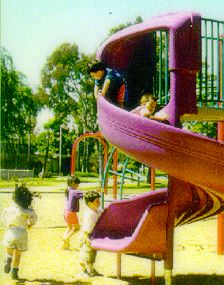 City
of El Cajon is an integrated planning document that satisfies both the
California Housing Element requirements and the HUD Consolidated Plan requirements
for entitlement grant programs. This Best Practice nomination represents
an innovative approach to combining and aligning required City programs
for housing and community development. Pursuant to California Housing Element
law, El Cajon is required to prepare a Housing Element (HE) for the period
of July 1, 1999 through June 30, 2004. The HE provides an analysis of the
community’s housing needs based on demographic trends and housing
market conditions, an evaluation of constraints to housing development,
and an inventory of residential land and financial resources. The focus
of the HE is a comprehensive housing plan with goals, policies, and implementation
programs to address identified needs and mitigate constraints with available
resources.
City
of El Cajon is an integrated planning document that satisfies both the
California Housing Element requirements and the HUD Consolidated Plan requirements
for entitlement grant programs. This Best Practice nomination represents
an innovative approach to combining and aligning required City programs
for housing and community development. Pursuant to California Housing Element
law, El Cajon is required to prepare a Housing Element (HE) for the period
of July 1, 1999 through June 30, 2004. The HE provides an analysis of the
community’s housing needs based on demographic trends and housing
market conditions, an evaluation of constraints to housing development,
and an inventory of residential land and financial resources. The focus
of the HE is a comprehensive housing plan with goals, policies, and implementation
programs to address identified needs and mitigate constraints with available
resources.